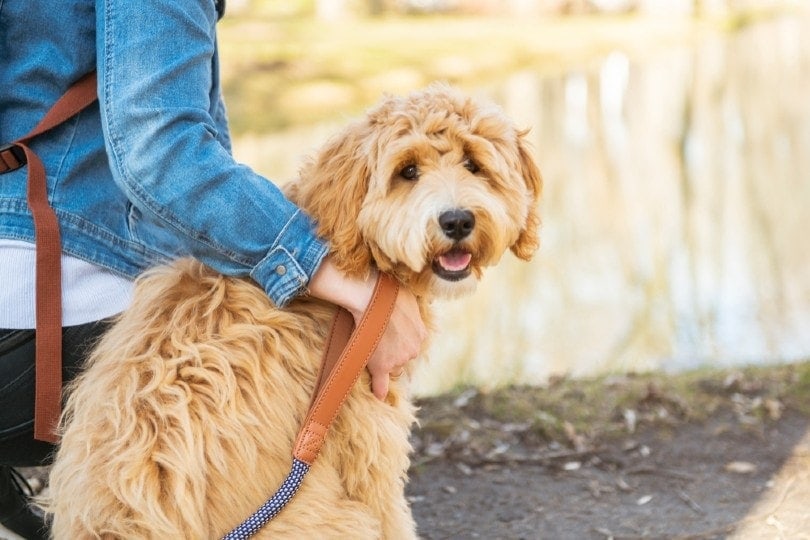How Long Do Labradoodles Live? Average Lifespan, Data & Care

Updated on

Click to Skip Ahead
If you’re a proud owner of a Labradoodle, you know firsthand how amazing these furry companions can be. With their fun-loving personalities, intelligence, and affectionate nature, it’s no surprise that Labradoodles are one of the most popular dog breeds around.
There are several factors that can affect the longevity of a Labradoodle, with an average lifespan of around 12 years. In this article, we’ll explore the various factors that can impact your Labradoodle’s lifespan, including nutrition, genetics, exercise, and healthcare. Hopefully, with this information in hand, you’ll be equipped to give your furry friend the best possible chance at a long and healthy life.
What’s the Average Lifespan of a Labradoodle?
The average lifespan of a Labradoodle is between 12 and 15 years. Labradoodles are a mix between a Labrador Retriever and a Poodle. Labradors usually live between 10 and 12 years on average and Poodles usually live between 12 and 15 years. So, in reality, a Labradoodle could live longer or shorter than the average lifespan depending on several factors.

Why Do Some Labradoodles Live Longer Than Others?
One of the most significant factors that can impact a Labradoodle’s lifespan is genetics. Inherited traits from both the Labrador Retriever and Poodle can have an impact on a Labradoodle’s health and lifespan, particularly health conditions. Here are some of the other factors that can impact their longevity.
1. Nutrition
Nutrition is an important factor that can impact your Labradoodle’s lifespan. A healthy and balanced diet is essential for ensuring that your furry friend lives a long and healthy life. Some of the factors to consider when it comes to your Labradoodle’s diet include the quality of the food, proper portions, and what types of treats they are fed.
Quality of Food
The quality of the food that you feed your Labradoodle can have a significant impact on their overall health and lifespan, just like with us humans. It’s essential to choose high-quality dog food that is free from unnecessary fillers and artificial ingredients. Look for dog food that contains high-quality, meat-based protein, healthy fats, and essential vitamins and minerals.
Portion Control
We also need to ensure that your dog stays in shape and doesn’t overeat. Overfeeding can lead to obesity (especially as dogs age), which can increase the risk of health issues and reduce their lifespan. Always follow the feeding guidelines on the dog food packaging and adjust the portion size based on your Labradoodle’s activity level and weight.
Doggy Treats
Like with any other breed, treats can play a large part in your Labradoodle’s life, but it’s important to choose ones that are healthy and low in calories. Avoid giving your dog table scraps, as these can be high in fat and calories.
Instead try to find healthy commercial treats to offer your dog that are low in additives and fat, all you can even make your own treats at home using dried meat, fruits, and veggies. Just don’t overdo it on the treats either, which can also lead to weight gain.
2. Size
The size of your Labradoodle can have an impact on their lifespan. For example, larger dogs tend to have shorter lifespans than smaller dogs. This is because larger dogs often are more prone to certain health conditions affecting the joints and other body parts due to having a larger body weight. The average lifespan for large breed dogs is about 7 to 10 years, while smaller dogs tend to live about 14 years on average.
Labradoodles in general are considered to be medium-sized dogs, but some can be larger or smaller depending on the size of the Poodle parent. Labradoodles can be created from Standard or Miniature Poodles, but Labradoodles bred from Miniature Poodles are known as Mini Labradoodles. Mini Labradoodles may live longer than their larger counterparts because they have a lower potential for developing serious health issues.

3. Health Issues
Labradoodles can be prone to certain health issues that can impact their lifespan. These health issues can reduce the lifespan of your Labradoodle and can also impact their quality of life. Labradoodles can inherit health issues from either the Labrador or Poodle parent, particularly issues that are common in the two breeds.
To ensure that your Labradoodle lives a long and healthy life, it’s important to choose a reputable breeder who selects breeding pairs carefully. A reputable breeder will perform health checks on the parents of the puppies to ensure that they are healthy and free from genetic health issues.
Here are some health issues that Labradoodles are prone to. But note that with proper veterinary care, you can manage and prolong your dog’s lifespan.
Hip Dysplasia
Hip dysplasia is a genetic condition that can impact the hips of Labradoodles, just like with many dog breeds. It can cause pain and discomfort and can make it difficult for your dog to get around the home and do typical mobile activities. It develops in puppyhood but doesn’t become as noticeable until the dog ages. With management and surgery, your Labradoodle can still live a long life.
Eye Problems
Labradoodles can be prone to certain eye problems, such as cataracts and progressive retinal atrophy. These conditions can impact their vision, which can in turn lower their quality of life and make them less likely to notice dangers around them which could potentially result in a shorter lifespan. The best way to prevent them and treat them is to catch them early. In some cases, veterinarians can perform surgery or prescribe medicines to prevent these issues from worsening or treat them completely.
Skin Conditions
Labradoodles with curly or wooly coats can be more prone to certain skin conditions, such as hot spots, infections, and allergies. These conditions can be uncomfortable and cause you to notice different behavior in your dog such as constant fighting, licking, or scratching certain areas on its body.
By being aware of these common health issues in combination with regular veterinary care and a healthy diet and exercise routine can help to prevent these health issues from occurring.
4. Exercise/Activity
Exercise will also have a pretty significant effect on your Labradoodle’s lifespan. Regular exercise is essential for maintaining a healthy weight, reducing the risk of health issues, and improving their overall quality of life. Below are a few things to focus on when it comes to exercise and making sure that your Labradoodle is getting enough of it to help them live a long and happy life.
Activity Level
The activity level of your Labradoodle will depend on their age, size, and overall health. Puppies and younger dogs will require more exercise than older dogs. Overall, make sure that your dog is getting at least an hour of physical activity each day. This can come in the form of walking, playing, or simply letting the dog run around the backyard.
Type of Exercise
The type of exercise that your Labradoodle needs will depend on their age and overall health. Younger dogs may benefit from more vigorous exercise, such as running, while older dogs may benefit from more gentle exercise, such as walking or swimming.
Exercise Frequency
The frequency of exercise that your Labradoodle needs will depend on their age and overall health. So, while it’s essential to provide your Labradoodle with regular exercise, be careful not to overdo it, especially with young or mature pups. Over-exercising can lead to injury and can impact their overall health and lifespan.

5. Healthcare
And of course, healthcare plays a large role in a dog’s life span as well. Regular veterinary care is essential for maintaining your Labradoodle’s overall health and wellbeing. Not only will it help you prevent certain issues with your Labradoodle, but it can help you save money on potential healthcare treatment costs if you can get ahead of potential health issues before they become serious. Some of the factors to consider when it comes to your Labradoodle’s healthcare include:
Regular Vaccinations
Vaccinations are a huge part of your Labradoodle’s healthcare. Regular vaccinations can help to prevent the spread of infectious diseases and can keep your furry friend healthy. Common canine vaccines include rabies, Borrelia burgdorferi, Bordetella bronchiseptica, and Leptospira bacteria.
Parasite Control
Parasite control and treatment also has its place in your dog’s regular vet visits. Regular flea and tick treatments can help to prevent infestations and anemia, and regular deworming can help to prevent intestinal parasites such as worms which can affect your dog’s eating habits and digestion.
Dental Care
And you can’t neglect your Labs teeth and gums. Dental care is often overlooked when it comes to pet healthcare, but it is important to your dog’s quality of life. Regular dental cleanings can help to prevent dental disease and you can also assist in your dog’s dental care by brushing its teeth a few times a week and offering treats that are specialized to offer dental benefits.
The Life Stages of a Labradoodle
Puppy
A Labradoodle is considered to be in the puppy stage up until about 1 to 1 ½ years old. During this time, their body will continue to develop, they may grow in both weight and height, and they will reach sexual maturity.

Young Adult
Labradoodles between the ages of 2 and 4 years old are considered to be young adults. During this time, they will be the most playful and energetic versions of themselves and their bodies should be fully developed and at their healthiest.
Mature Adult
A Labradoodle is considered to be a mature adult between the ages of 4 and 8 or 9 years old. During this time, they may still be playful and energetic but they will start to slow down and may start to put on weight if they don’t exercise as much. Some minor potential health problems may start to develop during this time.

Senior
Labradoodles are senior dogs around age 9 or 10 and older. Senior dogs will have less energy, they may play less and sleep more, and they are the most prone to developing health issues, some of which may be more serious. A proper diet and regular veterinary care is crucial during this time of your Labradoodle’s life to help maintain their health as much as possible.
 How to Tell Your Labradoodle’s Age
How to Tell Your Labradoodle’s Age
The only surefire way to know your Labradoodle’s age is to get them from a breeder that will have documentation stating exactly when they were born. If you get your Labradoodle from a shelter, your vet can look at various aspects of your Labradoodle, particularly their teeth, and give you their best estimate of their age.
You can also look for signs that your dog is aging, such as some of the hairs on their coat turning gray or white. Your dog may also start to slow down and be less active, have a decreased appetite, or is starting to gain weight. Your dog’s dental health may also start to deteriorate even with regular dental care.
Wrapping Things Up
Understanding the various factors that can impact your Labradoodle’s lifespan is really a must for any pet owner. By providing your furry friend with a healthy diet, regular exercise, and regular vet care, you can help to ensure that they live a long and healthy life. With these tips and advice in mind, you can give your Lab the best possible chance at a long and happy life.
See Also:
Featured Image Credit: Danita Delimont, Shutterstock

 How to Tell Your Labradoodle’s Age
How to Tell Your Labradoodle’s Age








